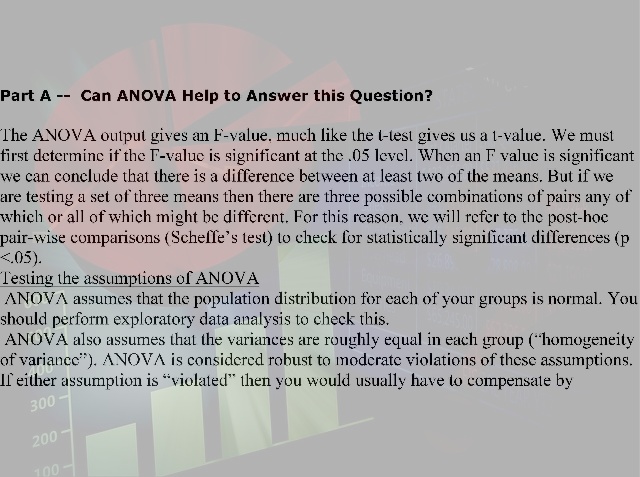[Solution] The ANOVA output gives an F-value, much like the t-test - #80026
Part A -- Can ANOVA Help to Answer this Question?
The ANOVA output gives an F-value, much like the t-test gives us a t-value. We must first determine if the F-value is significant at the .05 level. When an F value is significant we can conclude that there is a difference between at least two of the means. But if we are testing a set of three means then there are three possible combinations of pairs any of which or all of which might be different. For this reason, we will refer to the post-hoc pair-wise comparisons (Scheffe’s test) to check for statistically significant differences (p <.05).
Testing the assumptions of ANOVA
ANOVA assumes that the population distribution for each of your groups is normal. You should perform exploratory data analysis to check this.
ANOVA also assumes that the variances are roughly equal in each group (“homogeneity of variance”). ANOVA is considered robust to moderate violations of these assumptions.
If either assumption is “violated” then you would usually have to compensate by applying the non-parametric equivalent of ANOVA (i.e. use Kruskal-Wallis test). However, for the purpose of this exercise, use ANOVA regardless, and in your write-up indicate the status of these assumptions.
Assignment
1) You have been given an assignment to review the Ugandan database from the HIV/AIDS Survey of Ugandan women to help develop an approach to a HIV/AIDS Intervention/Education program for countries in central Africa, including Uganda. Which variables provide the information you need to analyze to identify which specific subpopulation (group) should be targeted for an HIV/AIDS Intervention/Prevention/Education Program?
Ugandan-SPSS-Data.sav
All variables are to be considered as possible variables to be analyzed: [(ie) Ever use of condom, Have a regular sex partner other than spouse, Current marital status, Perception of Chances of getting AIDS, knows ways to avoid AIDS, Age at first sexual intercourse, region, Age at first marriage, age group, religion, watches tv/listens to radio. Select those that will be applicable to targeting this population and will be appropriate for the statistical tests noted below.
2) Analyze the data using the following statistical tests (Use at least one of the following tests in your analysis):
A. Descriptive Statistics (Crosstabs and Chi-Square if appropriate)
B. Independent t-Tests
C. One-Way ANOVA (Required in the analysis)
D. Two-Way ANOVA
3) Provide an appropriate interpretation of the information developed from your analysis.
4) Identify which specific sub-population (group) of women to be targeted for the HIV/AIDS Intervention/Prevention/Education Program. This should be the group that your data shows will most likely benefit the most from such a program.
Part B -- Measuring the Effects of Classical Music on a Group of Test Takers (Experimental Research)
The question of the effect of background classical music (Mozart or Chopin) while a student studies on their ability to learn and perform better on exams has often been debated among some researchers. For this study we will attempt to determine if students perform better on an examination when exposure to classical music (Chopin or Mozart) while taking an examination in math and reading. To test this theory a study was set-up as follows:
Study Subjects: Sixth graders
Inclusion Criteria: All participating students must have tested at grade level or higher in both reading and math on their last SAT 9 or other test as required by the State where the experiment will be conducted.
Number of Subjects: 300 randomly assigned to three groups.
There are 150 females and 150 males.
Each group has 50 males and 50 females randomly assigned.
Testing Conditions:
Condition A: Classical Music played in background at a level which is 5 dBA over ambient levels
Condition B: Traffic noise played in background at a level of 60 dBA
Condition C: Quiet testing room which meets all recommended standards for testing conditions
Students are randomly assigned to one of the three testing facilities meeting the conditions described above. They take one examination under only one of the three testing conditions (Math or reading) and then take the second examination after a 45 minute break. There will be only 100 students tested per noise testing condition.
The database Noise-Testing Scores provides you with the testing results for each student tested by testing condition. Review the database once it is opened in SPSS.
Given the variables measured for this study (See Variable View of Noise-Testing Scores database in SPSS data editor view), list the various statistical tests that you are able to perform with the database using SPSS.
Write a hypothesis for testing the theory that classical music may increase students performance. Make sure that your hypothesis is relevant to this specific case and database.
Deliverable: Word Document
 and pdf
and pdf





